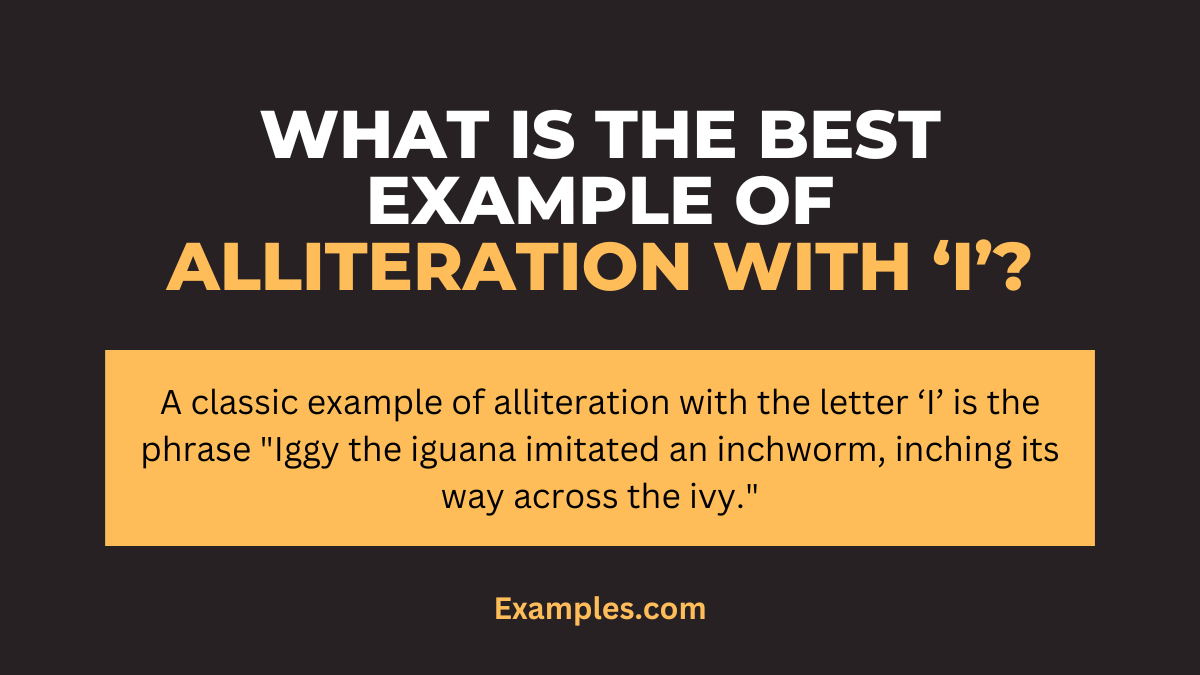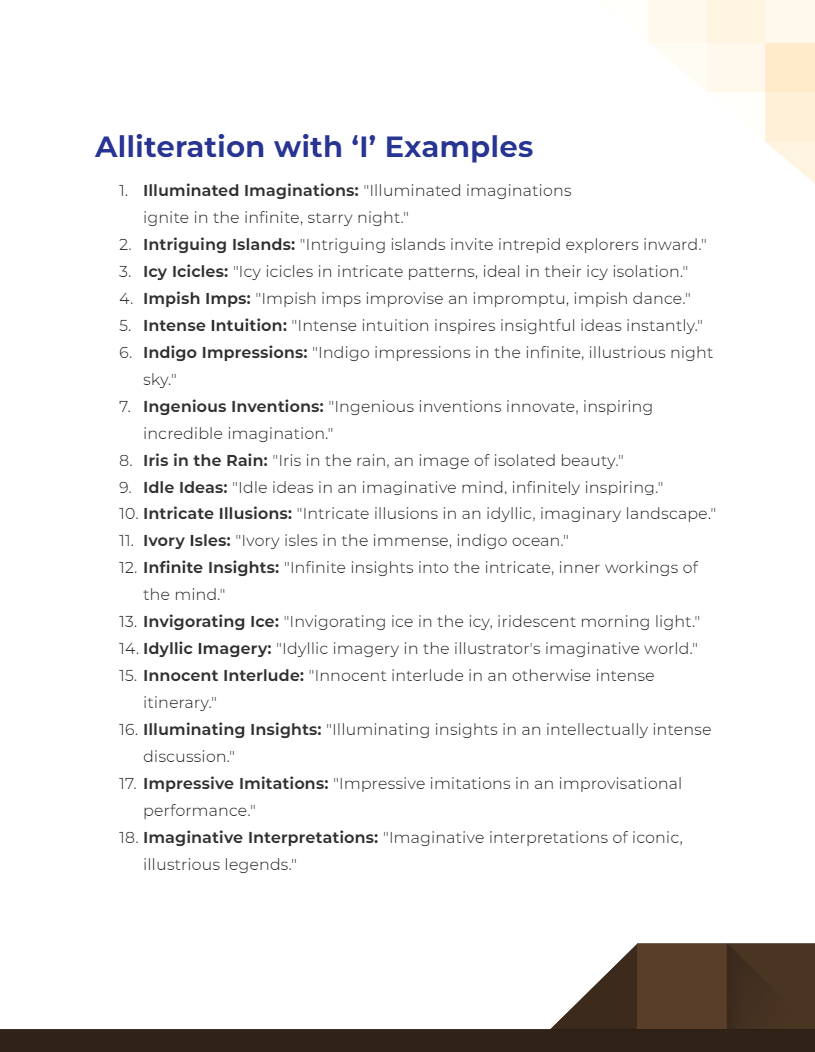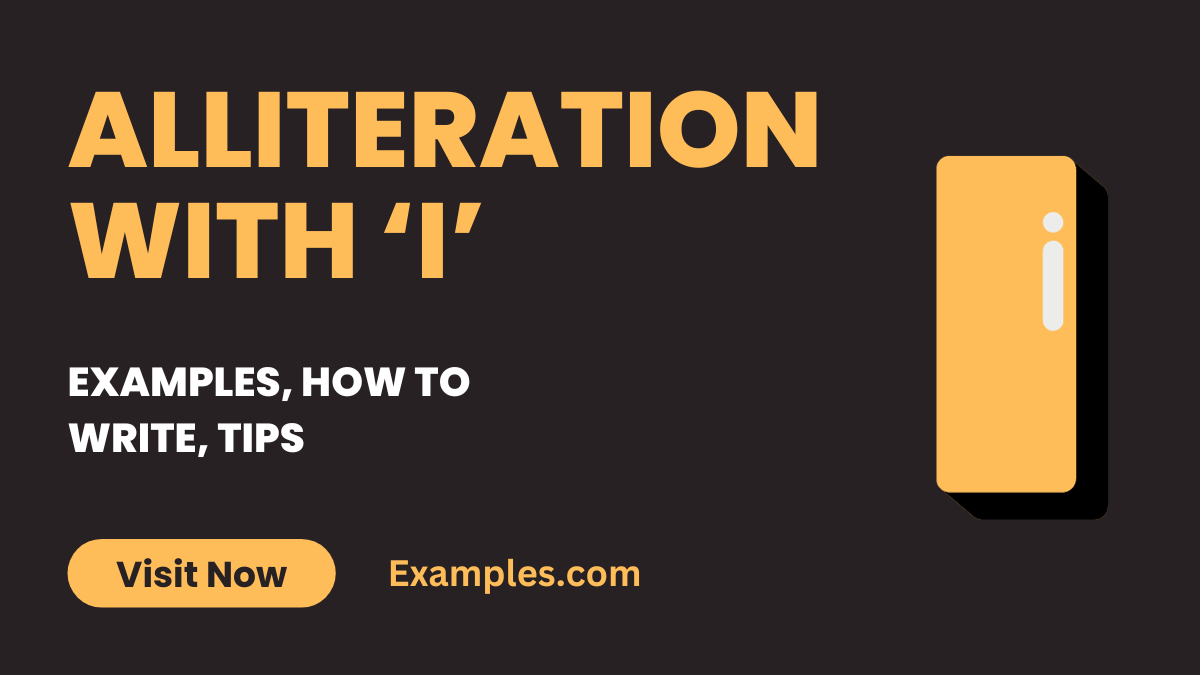17+ Alliteration with I Examples
Alliteration with the letter ‘I’ is a creative and intriguing aspect of language that can add a lyrical quality to writing. It involves the repetition of the ‘I’ sound at the beginning of words in close succession. This technique is often used in poetry and prose to create a musical effect, emphasizing certain points or enhancing the mood. Crafting sentences or phrases with alliteration requires a keen ear for sound patterns and a playful approach to word choice. Understanding and mastering first grade alliteration with ‘I’ can bring a unique flair to both creative and formal writing, engaging readers with its rhythmic and harmonious sound.
Download Alliteration with 'I' Examples
Download Alliteration with 'A' to 'Z' Examples
What is the Best Example of Alliteration with ‘I’?

Example: A classic example of alliteration with the letter ‘I’ is the phrase “Iggy the iguana imitated an inchworm, inching its way across the ivy.”
Meaning: Alliteration is a literary device where consecutive words in a sentence or phrase begin with the same consonant sound. In the easy alliterative example “Iggy the iguana imitated an inchworm, inching its way across the ivy,” the consonant ‘I’ is repeated at the beginning of several words, creating a rhythmic and engaging sound pattern. This technique is often used in literature and poetry to add emphasis, musicality, and memorability to the text. In this specific example, the repeated ‘I’ sound enhances the image of the iguana mimicking an inchworm’s slow movement, making the sentence more vivid and enjoyable to read or hear.
20 Alliteration with ‘I’ Examples

Download Alliteration with 'I' Examples in PDF
Alliteration using the letter ‘I’ infuses writing with an imaginative and insightful touch. The ‘I’ sound, whether pronounced as in ‘ice’ or as in ‘illusion’, lends itself to both hard alliteration examples. These perfect for enriching various forms of writing, including alliteration in rhymes. It can be used to create vivid visual imagery or to add a rhythmic, poetic dimension to language, especially notable in alliteration in rhymes. Here are 20 unique examples of alliteration with ‘I’, each paired with a rhyme title to enhance the charm of the phrase.
- Illuminated Imaginations: “Illuminated imaginations ignite in the infinite, starry night.”
- Intriguing Islands: “Intriguing islands invite intrepid explorers inward.”
- Icy Icicles: “Icy icicles in intricate patterns, ideal in their icy isolation.”
- Impish Imps: “Impish imps improvise an impromptu, impish dance.”
- Intense Intuition: “Intense intuition inspires insightful ideas instantly.”
- Indigo Impressions: “Indigo impressions in the infinite, illustrious night sky.”
- Ingenious Inventions: “Ingenious inventions innovate, inspiring incredible imagination.”
- Iris in the Rain: “Iris in the rain, an image of isolated beauty.”
- Idle Ideas: “Idle ideas in an imaginative mind, infinitely inspiring.”
- Intricate Illusions: “Intricate illusions in an idyllic, imaginary landscape.”
- Ivory Isles: “Ivory isles in the immense, indigo ocean.”
- Infinite Insights: “Infinite insights into the intricate, inner workings of the mind.”
- Invigorating Ice: “Invigorating ice in the icy, iridescent morning light.”
- Idyllic Imagery: “Idyllic imagery in the illustrator’s imaginative world.”
- Innocent Interlude: “Innocent interlude in an otherwise intense itinerary.”
- Illuminating Insights: “Illuminating insights in an intellectually intense discussion.”
- Impressive Imitations: “Impressive imitations in an improvisational performance.”
- Imaginative Interpretations: “Imaginative interpretations of iconic, illustrious legends.”
- Indelible Impressions: “Indelible impressions in the imaginative artist’s mind.”
- Irresistible Invitation: “Irresistible invitation to an idyllic, imaginary world.”
Alliteration Sentence Examples with ‘I’
Alliteration sentence examples with ‘I’ showcase the impact of this literary device in creating memorable and rhythmic phrases. The ‘I’ sound, used in various contexts, can offer both a soft and sharp auditory experience. This type of alliteration is seen across various forms of media, including alliteration in poems, songs, and even movies. Here are three examples:
- “Intriguing insights illuminated Ivan’s intense investigation.”
- “Iris’s icy gaze instantly intimidated her inquisitive interviewer.”
- “Invisible ink inscribed intimate, insightful ideas.”
Alliteration Examples with ‘I’ Words
Alliteration examples with ‘I’ words demonstrate how the repetition of the ‘I’ sound can create a smooth, flowing effect in language. This form of alliteration is often utilized in alliteration in movies for its rhythmic quality. Here are three examples:
- “Impish imps in ivory attire idly imagine.”
- “Ivy intertwines in the intricate iron fence.”
- “Isolated islands in the immense, indigo sea inspire imagination.”
Alliteration Poem with ‘I’
An alliteration poem with ‘I’ uses the repetitive ‘I’ sound to create a rhythmic and engaging poetic experience. Alliteration in poems, especially with the ‘I’ sound, adds a unique lyrical quality that can be both captivating and thought-provoking. Here are three examples:
- “In islands of ice and ivy intertwined, / Imaginations ignite, ideas in mind.”
- “Invisible in the ink of the night, / Illuminated only by the moon’s light.”
- “In idle hours, ideas ascend, / In imagination’s realm, they blend.”
Alliteration Starting with ‘I’
Alliteration starting with ‘I’ sets a specific tone and rhythm in a phrase, often creating a memorable impact. This form of alliteration can be found in various artistic expressions, including alliteration in songs and movies, where it adds a lyrical or dramatic flair. Here are three examples:
- “Ivan’s intriguing invention instantly impressed the audience.”
- “Ingrid’s infectious laughter ignited joy in the room.”
- “Iridescent icebergs, imposing and immense, inspire awe.”
How to Write Alliteration with ‘I’?
Writing alliteration with the letter ‘I’ involves using words that begin with the ‘I’ sound in close proximity within sentences or phrases. This can create a rhythmic and sometimes introspective effect in writing. Here’s a guide to crafting effective alliteration with ‘I’, which can be particularly useful for creating alliteration with answers or as part of alliteration figurative language exercises:
- Identify the ‘I’ Sound: Recognize that the ‘I’ can have different sounds, such as the long ‘I’ in ‘ice’ or the short ‘I’ in ‘it’. Decide which sound you want to use for your alliteration.
- Choose a Theme: Select a theme or subject. This helps in choosing ‘I’ words that are relevant and coherent with your topic, especially important when creating great alliteration examples for educational purposes.
- Brainstorm ‘I’ Words: Make a list of words starting with the ‘I’ sound. A thesaurus or dictionary can be handy for expanding your word choice.
- Create Your Sentence: Formulate a sentence or phrase using the ‘I’ words. Focus on creating a natural flow that emphasizes the alliterative effect.
- Read Aloud for Rhythm: The effectiveness of alliteration is often best judged audibly. Reading aloud helps ensure it has a pleasing rhythm, a key component in alliteration figurative language.
- Revise for Impact: Edit your sentence for clarity and impact. The goal is to enhance your message with alliteration without making it feel forced.
- Apply in Context: Integrate your alliterative phrase into your text. This technique is effective in various contexts, from creative writing to educational materials like alliteration for first grade.
Tips for Using Alliteration with ‘I’
Here are the Tips for Using Alliteration with ‘I’:
- Use Moderately: Overuse of alliteration can overshadow the content. Use it sparingly to emphasize key points or to add a stylistic touch.
- Ensure Clarity: The primary goal of your writing should be to convey your message clearly. Alliteration should not compromise the comprehensibility of the text.
- Vary Word Choices: Incorporate a mix of short and long ‘I’ words, as well as different types of speech (nouns, verbs, adjectives), for a more dynamic effect.
- Consider the Mood: The ‘I’ sound can be introspective or impactful. Choose words that match the mood and tone you aim to convey.
- Read Out Loud: This helps in assessing the rhythm and flow, crucial in alliteration figurative language and in creating great alliteration examples.
- Avoid Forced Repetition: Natural-sounding alliteration is more effective and engaging. Avoid cramming ‘I’ words where they do not fit naturally.
- Experiment in Various Contexts: Try using alliteration in different writing styles and formats. It can be a valuable tool in creative writing, educational content, and even in professional settings.
Remember, the key to effective alliteration with ‘I’ is to balance creativity with clarity, ensuring that your alliteration enhances rather than detracts from your overall message.
What are the Alliteration Tongue Twisters with ‘I’?
Alliteration tongue twisters with ‘I’ are phrases designed to be challenging to articulate, often using a series of words that start with the ‘I’ sound. These tongue twisters are not only fun but also beneficial for improving diction and pronunciation. They can be used as a language tool in various contexts, such as alliteration for students, alliteration for kids, and even alliteration for adults who enjoy linguistic challenges. Here are some examples:
- “Iris insists on iridescent insects in Illinois.”
- “Ingrid’s iguana imagined an immense iceberg.”
- “Ivan and Imogen idly improvised an intricate improvisation.”
These tongue twisters can be an entertaining way to explore alliteration and assonance, enhancing language skills.
What is the Effect of ‘I’ Letter in Alliteration?
The effect of the ‘I’ letter in alliteration is multifaceted. The ‘I’ sound, whether short as in ‘igloo’ or long as in ‘item’, can create a rhythmic, intriguing, and sometimes intense auditory experience. In literature, ‘I’ alliteration adds a unique lyrical quality to the text, making it more memorable and engaging. It can be used for emphasis, to create mood, or to add a poetic dimension to prose and poetry. Famous alliteration examples often harness the power of ‘I’ alliteration to create impactful phrases that resonate with readers.
What is the Alliteration ‘I’ Type of?
Alliteration with the letter ‘I’ is a type of consonantal alliteration, even though it involves a vowel sound. This form involves the repetition of the initial ‘I’ sound in adjacent or closely connected words. It’s a popular literary device used in various forms of writing, from creative poetry to effective prose. ‘I’ alliteration can be found in great alliteration examples, in educational material like alliteration for students, and in entertaining content aimed at younger audiences, such as alliteration for kids. The versatility of ‘I’ alliteration also makes it a favorite in alliteration and assonance exercises, where it serves both artistic and educative purposes.


